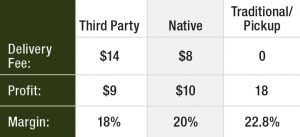Delivery profitability remains one of the biggest debates in the food-delivery space. The COVID-19 pandemic has amplified that topic dramatically as the majority of restaurants continue doing a huge portion of their business in pickup and delivery channels.
A large number of operators are either looking at profitability for the first time or reassessing as more of their business is going out via delivery. For either, it’s worth a bit of a thought experiment about the delivery economics.
For our hypothetical FODrucker’s restaurant, let’s take a look at the impact of delivery and pickup orders, and then explore how native orders versus third-party platform ordering changes the math.
Let’s assume the restaurant has some pretty standard or slightly above average numbers as a baseline with 40 percent of sales as cost of goods sold (COGS) including food, paper, marketing and other overhead. Labor typically runs 25 percent of sales. It has a contract with a third-party platform that charges 27 percent of the ticket price, which drops to 15 percent for white-label deliveries when the restaurant generates the digital order.
Scenario A: Standard Orders Online
 In this scenario, the restaurant has an average check of $10 per person. When that order is placed on a third-party platform, just $1 flows to the bottom line. Capturing the order on the restaurant’s own digital infrastructure produces a better margin, but still not much by way of profit as seen in the accompanying chart.
In this scenario, the restaurant has an average check of $10 per person. When that order is placed on a third-party platform, just $1 flows to the bottom line. Capturing the order on the restaurant’s own digital infrastructure produces a better margin, but still not much by way of profit as seen in the accompanying chart.
At that $1 profit, it’s hard to rationalize keeping the restaurant open outside of peak hours, if at all. That’s the math a lot of new operators assume when getting into delivery for the first time. For in-house orders via the restaurant’s own technology, things are a little better.
Scenario B: Higher Tickets 
Even pre-pandemic, delivery tended to produce higher order sizes as customers order for families, groups or multiple meals to rationalize the cost of the delivery fees. Many restaurants were successful at pushing that even further with family meals, suggestive selling and leaning into larger orders however they could.
Pushing the ticket to $50 doesn’t change the margin, but higher topline sales can solve a lot of problems and maybe help keep the proverbial lights on. Native orders do much better at large order sizes.
Scenario C: Marketing Support/Discounts 
In interviews with numerous operators, they highlighted receiving a lot of pandemic-era support from the third-party platforms. Many were able to negotiate for some free or reduced marketing from the third-party platforms during the pandemic. While that might not last forever, it also helps illustrate how restaurant operators can think of the platforms as marketing channels. Assuming 25 percent of COGS goes toward marketing, the 27 percent fee becomes easier to digest.
When cutting marketing out of the equation, third-party delivery margins rise to almost meet what a company would spend driving people to the restaurant’s own digital ordering page. Even prior to the pandemic, this is how some operators who leaned into delivery thought about the platforms—not as another hit to the bottom line but as a different marketing bucket.
Scenario D: Tweaking Costs 
Finally, cutting COGS expenses makes the largest impact to the delivery margin. This is, of course, the hardest problem to solve in normal times. But there is a pandemic silver lining for restaurants that can make it work — a vastly reduced labor cost with no dining room. In QSR and fast-casual restaurants, operators said they could cut their standard 25 percent labor cost by half. At a 12.5 percent of sales, margins look much better across the board.
Operators focusing on high-margin items, reducing packaging costs or shedding hours all help here, as well. This is also why there some operators (namely in QSR) are happy to wait to re-open dining rooms and keep just enough staff to handle off-premises orders.
This is admittedly a simplified look at the delivery costs and profits, but it’s always good practice to think through this math. Operators said similar number crunching has helped both when negotiating with third-party delivery platforms and pondering the delivery menu.
One trend through all the scenarios is how much more profitable it is to capture customer orders and outsource the last mile delivery. That’s been a laser focus for many loyalty-savvy companies through the pandemic and there has been an explosion of ordering technology in the last 12 months as the industry pulls in this direction.
Editor’s note: This is a preview of a story that will appear in Franchise Times’ March issue.


